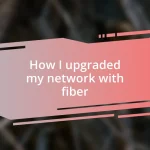Key takeaways:
- Understanding the basics of fiber cables, including single-mode vs. multi-mode and their unique characteristics, is crucial for optimizing network performance.
- Evaluating performance specifications such as bandwidth, attenuation, and maximum transmission distance is essential for matching cables to project needs.
- Considering environmental factors and total lifecycle costs helps in making informed decisions that enhance cable longevity and reduce long-term expenses.

Understanding fiber cable basics
Fiber optic cables are a marvel of modern technology, employing thin strands of glass or plastic to transmit data as light. When I first learned about these cables, I was fascinated by how they offer faster speeds and higher bandwidth than traditional copper cables. Can you imagine the difference in performance?
What really struck me was the unique construction of fiber cables. They consist of a core, cladding, and protective outer layers – a design that minimizes signal loss and encourages efficient data transmission. I remember the excitement I felt when I comprehended how light could carry information over long distances without degradation. It’s incredible to think about the science behind something that connects us more than ever.
Additionally, fiber cables come in two main types: single-mode and multi-mode. Each serves different purposes, and choosing the right type can significantly impact network performance. When selecting fiber for a project, I often found myself pondering which would suit my needs best. This decision-making process taught me that understanding the basics is crucial before diving into the specifics.

Identifying types of fiber cables
Identifying the types of fiber cables is essential for anyone looking to maximize their network performance. Each type has its own unique characteristics that align with specific needs. For instance, when I was working on a project that required long-distance communication, I quickly realized that single-mode fiber was the way to go. The clarity and distance it offered were just what I needed to ensure strong connections without loss of speed.
Here’s a snapshot of what to consider when identifying fiber cable types:
- Single-mode fiber: This cable has a small core diameter, allowing only one mode of light to travel, ideal for long distances. I recall how this feature transformed a challenging network setup into a seamless operation.
- Multi-mode fiber: With a larger core, this cable can accommodate multiple modes of light, making it perfect for shorter distances. I learned this firsthand when a multi-mode installation vastly improved in-building connectivity.
- Fiber construction: Different cable designs, such as loose or tight buffer, impact flexibility and installation methods. I remember selecting a loose-tube cable because it offered better performance in rugged environments.
Understanding these distinctions helped me make more informed decisions, ultimately improving the quality of my projects.

Evaluating cable performance specifications
Evaluating the performance specifications of fiber cables can seem daunting at first, but it’s a crucial step in ensuring optimal network functionality. I remember when I started delving into specifications, like bandwidth and attenuation levels. These metrics are vital—they directly impact how much data can be transmitted over a fiber cable and how signal strength diminishes over distance. For example, I once chose a cable with a high bandwidth that significantly improved the speed of a large office network, making a world of difference for the employees who rely on reliable connectivity.
When considering specifications, pay close attention to the fiber’s maximum transmission distance and its operating wavelength. I learned the hard way that choosing a fiber cable not suited for my intended distance would lead to frustrating connectivity issues. In one project, I opted for a cable with an inadequate maximum distance rating, resulting in signal loss that hindered overall performance. This experience taught me to match the fiber cable’s specifications with the specific needs of my projects.
Here’s a simple comparison of performance specifications that I found helpful:
| Specification | Importance |
|---|---|
| Bandwidth | Determines data transmission capacity; higher is better. |
| Attenuation | Measures signal loss over distance; lower values are preferable. |
| Maximum Transmission Distance | Length over which the signal remains usable; should meet project requirements. |
| Wavelength | Affects performance; certain wavelengths suit specific applications. |

Calculating installation requirements
When calculating installation requirements for fiber cables, I’ve learned that anticipating the layout of your network is key. I vividly remember a time when I underestimated the number of cables needed for a sprawling office space, leading to delays that could have been avoided. By carefully measuring distances and mapping out the cable routes beforehand, I’ve been able to avoid such pitfalls and optimize the installation process.
Cable management is another area that often gets overlooked. I recall feeling overwhelmed by the tangled mess of cables in one of my earlier projects; it not only looked chaotic but also made maintenance more challenging. Planning for proper cable management—using trays or conduits—can streamline future upgrades and repairs. Have you ever faced a similar situation? Organizing cables not only improves aesthetics but also enhances overall system efficiency.
Finally, consider the environment where the installation occurs. I remember selecting a fiber cable that was not rated for outdoor use, resulting in unexpected issues with exposure to elements. By assessing whether your cables will be indoors or outdoors, and if they’ll encounter harsh conditions, you can make a smarter choice that ensures longevity and reliability. Taking the time to calculate these requirements can save both time and frustration down the line.

Assessing environmental factors
Assessing environmental factors is truly an essential step when selecting the right fiber cables. I remember one project where I underestimated the impact of humidity on cable performance. After installation, the cables experienced significant signal interference due to the moisture in the air. That experience taught me to always consider the environmental conditions—such as temperature and humidity—where the cables will operate.
I also encountered the importance of understanding whether the cables will be exposed to sunlight or extreme temperatures. Picking a cable that wasn’t UV resistant for an outdoor installation led to premature degradation. I still cringe when I think about the extra costs incurred from having to replace those cables sooner than expected. I now make it a point to select cables designed to withstand the specific environmental challenges of their location.
Have you ever stopped to think about how dust and debris could affect fiber optic cables in industrial settings? I learned this lesson during a project in a manufacturing plant where airborne particles caused connectivity issues. It convinced me that diligent environmental assessments were just as crucial as gathering performance specifications. Going the extra mile to ensure cables are suited for their intended environments can save a lot of trouble later on.

Comparing costs and budgets
When it comes to costs and budgets, I’ve realized that price isn’t everything. I once picked a seemingly cheaper cable option, only to face higher installation and maintenance costs down the line. That taught me the hard way to look beyond the initial price tag and consider the total lifecycle cost, including performance and durability. Have you ever noticed how a solid investment up front can lead to savings in the long run?
Budgeting for fiber cables also requires a careful balance between quality and affordability. In my experience, it’s crucial to allocate funds not just for the cables themselves but also for the tools and expertise needed for installation. I remember a project where skimping on labor led to errors that ultimately increased costs. Sometimes, spending a little more on a professional installation can prevent headaches and unpredicted expenses later on.
Another aspect I’ve found helpful is exploring different suppliers to find the best deals without sacrificing quality. I’ve seen how the same type of cable can vary significantly in price based on the vendor, and taking the time to compare options can yield surprising savings. Have you ever hunted for the best price? It’s often worth it, and the effort can pay off handsomely in your overall budget.















